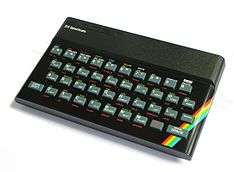Hobbit (computer)
|
| |
| Type | Home computer |
|---|---|
| Release date | 1990 |
| Operating system | Sinclair BASIC, Logo, CP/M, Forth |
| CPU | clone of Zilog Z80 @ 3.5 MHz |
| Memory | 64 KB including 6.5 KB screen memory |
Hobbit (Хоббит) is a Soviet/Russian 8-bit home computer, based on the Sinclair ZX Spectrum hardware architecture. It also featured a CP/M mode and Forth mode or LOGO mode, with the Forth or LOGO operating environment residing in an on-board ROM chip.[1]
Hobbit was invented by Dmitry Mikhailov (Russian: Дмитрий Михайлов) (all R&D) and Mikhail Osetinskii (management) (Михаил Осетинский) in Leningrad, Russia in the late 1980s. Its first circuitry layout was designed on a home-made computer (built using ASMP of three KR580 chips in 1979), the Soviet clones of Intel 8080), by Dmitry Mikhailov as well. The computer was manufactured by the joint venture InterCompex.[2]
Hobbit was marketed in the former Soviet Union as a low-cost personal computer solution for basic educational and office business needs, in addition to its obvious use as a home computer. Schools would buy it for a classroom, interconnecting several machines in a 56K baud network. It was possible to use either another Hobbit or a single IBM PC compatible computer as a master host on the network; a special Hobbit network adapter card by InterCompex was needed for the IBM PC in the latter case.
Hobbit was also briefly marketed in the U.K., targeted mainly at the existing ZX Spectrum fans willing to lay their hands on a better computer compatible with the familiar architecture. Though rarely available in the domestic market, export models featured the internal 3.5" drive, just like an Atari ST or an Amiga. Such models always had both the EGA and the TV output connectors operational, as well as the AY8910 sound chip. Domestic models often did not include either the TV output converter or the internal speaker or both. The AY8910 for the domestic models was sold separately as an external extension module, hanging off the same extension bus as the optional external disk drive. [3]
Another extension was the SME board (Screen and Memory Extension). This featured 32 KB cache memory, some of which could be dedicated to video text buffer in CGA mode (this was supported by drivers available only in the FORTH or the CP/M environments; no known programs using the Sinclair-based BASIC mode used this feature). SME worked at astonishing speed - one machine command made an output of entire display line. SME was capable of rendering several dozens of windows per second. SME capabilities were fully utilized only in Forth environment.
Technical details[4]
- Z80A with 3.5 MHz
- 64K RAM
- Disk drives: external 2 x 5.25" drives (up to 4 connectable) or internal 3.5" drive
- Connections: joystick (2xSinclair, 1xKempston), Centronics, RS232, audio in/out (for cassette recorder), system bus extension
- 74-key keyboard (33 keys freely programmable)
- Video output: analog TV, EGA monitor
- Operating system: built in disassembler, CP/M clone called "Beta", system language switchable between English and Russian
References
External links
General:
Press links:
The following two articles were published about Hobbit in the Your Sinclair magazine back in the early 1990s:
Hobbit was also briefly mentioned in
- this article from the ISSUE 98 APRIL 1992 of CRASH (magazine).
Then, later in 1992, Sinclair User featured the latest Hobbit-tech, elaborating also on FORTH and CP/M that the computer had. These articles probably give the best press coverage of Hobbit ever:
